Struggling to replicate that perfect cup of Joe from your favourite café at home? Did you know there are over 20 different ways to brew coffee, each with a unique flavour profile? This article is here to guide you through six traditional brewing methods – Pour Over, French Press, AeroPress, Siphon Method, Cold Brew and Drip Coffee.
Let’s embark on this caffeine-fuelled adventure together!
Key Takeaways
- There are six traditional brewing methods to make coffee at home: Pour Over, French Press, AeroPress, Siphon Method, Cold Brew, and Drip Coffee.
- Each brewing method has its own flavor profile and characteristics that contribute to the overall taste of the coffee.
- The equipment needed for each brewing method varies, but most methods can be done with simple and affordable tools.
- Choosing the right grind size and water temperature is important for achieving a delicious cup of coffee at home.
Different Brewing Methods for Making Coffee at Home
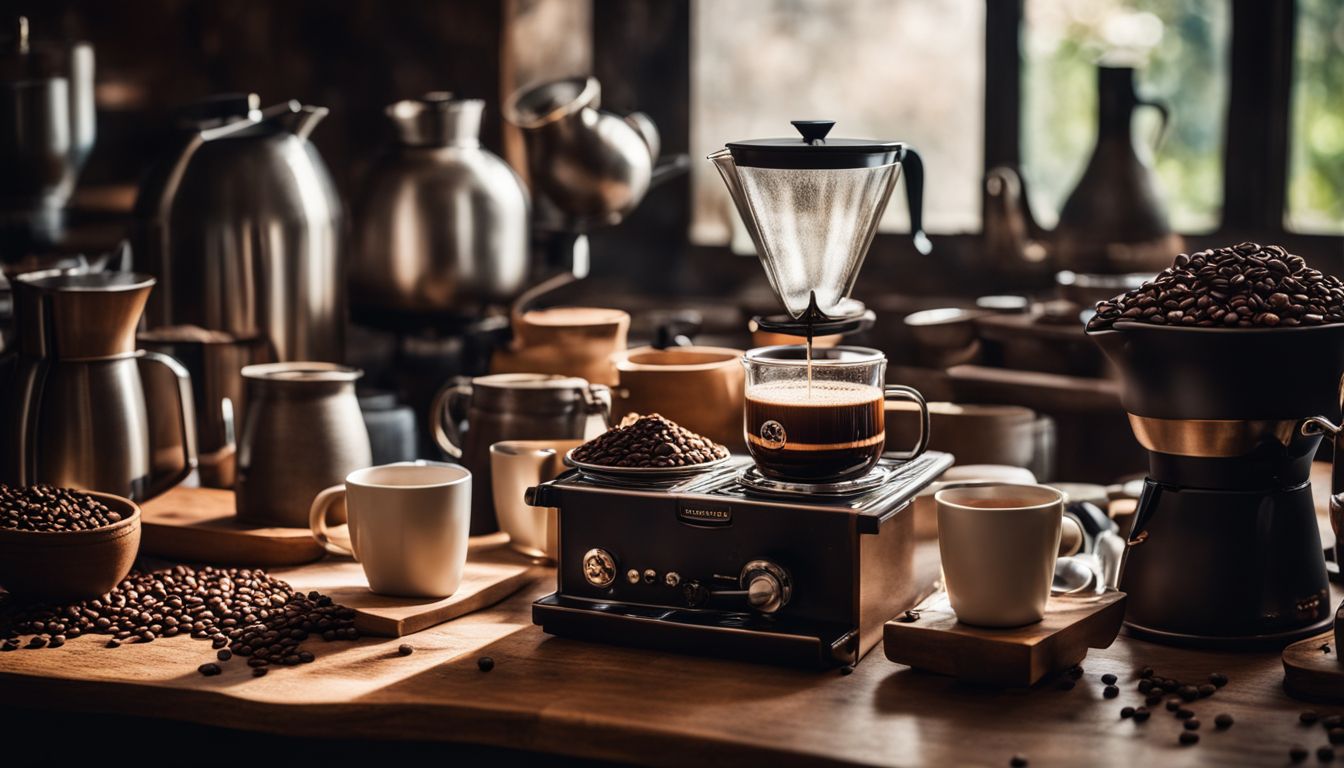
There are several different brewing methods you can use to make coffee at home, including the pour over method, French press method, AeroPress method, siphon method, cold brew method, and drip coffee method.
Pour Over Method
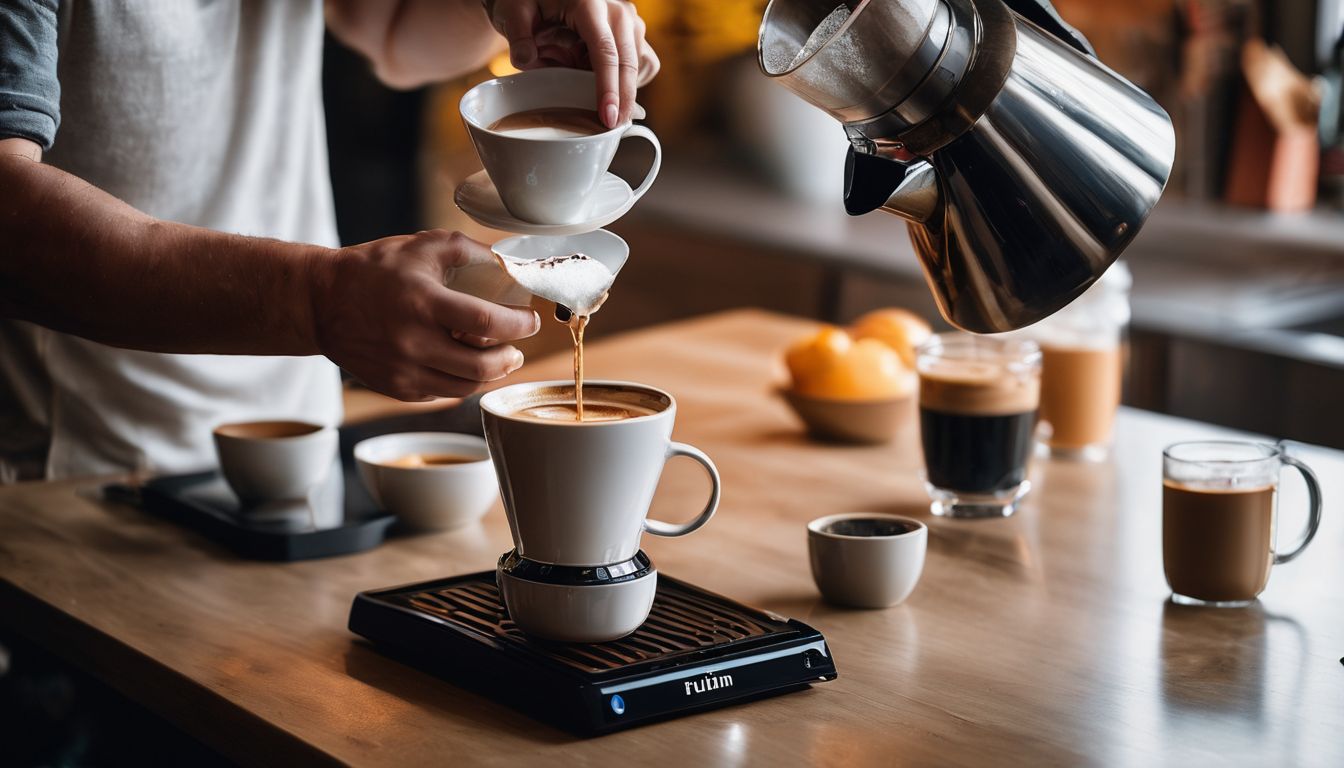
You take a cone and put it on your cup. Then you add a paper filter in the cone. Next, you pour ground coffee into the paper filter. Now comes the hot water. You pour it slowly over the coffee grounds.
Be sure to wet all of them! This way, coffee drips into your cup through the filter. It’s an old and easy way to make coffee at home, and also cheap.
French Press Method

The French Press method is a simple and popular way to make coffee at home. It involves steeping coarse coffee grounds in hot water for several minutes and then pressing down a plunger to separate the grounds from the brewed coffee.
This method allows for full extraction of the flavors and oils from the coffee, resulting in a rich and robust cup. The French Press is known for producing a smooth and distinct flavor profile, with some people describing it as having a fuller body compared to other brewing methods.
It’s also easy to use and requires minimal equipment, making it convenient for anyone looking to enjoy a homemade cup of joe.
AeroPress Method

The AeroPress method is a popular way to make coffee at home. It involves steeping coffee grounds in hot water and using air pressure to push the coffee through a filter. This process creates a smooth cup of coffee with low acidity and rich flavors.
The AeroPress is compact and portable, making it great for camping or traveling. It also has a quick brew time, taking only about 1-2 minutes from start to finish. Overall, the AeroPress method offers an easy and convenient way to enjoy a delicious cup of homemade coffee.
Siphon Method
The siphon method is a unique way to brew coffee at home. It uses a vacuum and pressure to create a delicious cup of coffee. This brewing method involves two chambers connected by a tube.
The water in the bottom chamber is heated, creating steam that pushes it into the top chamber where the coffee grounds are. As the water mixes with the grounds, it extracts all the flavors and oils from them.
After brewing for a specific time, the heat is removed, causing a vacuum effect that pulls the brewed coffee back down into the lower chamber, leaving behind any sediment or particles.
Cold Brew Method

The cold brew method is a popular way to make coffee at home. It involves steeping coffee grounds in cold water for an extended period of time, usually around 12-24 hours. This slow extraction process results in a smooth and less acidic cup of coffee.
Cold brew is great for beer drinkers who prefer a milder and less bitter flavor profile. It can be served over ice or mixed with milk for a refreshing and creamy drink. With its simple preparation and long shelf life, cold brew is perfect for those who like to plan ahead and have coffee ready to enjoy throughout the day.
So, if you’re looking for a delicious and easy way to make coffee at home, give the cold brew method a try!
Drip Coffee Method
The drip coffee method is one of the oldest and simplest ways to make coffee at home. All you need is a coffee cone and paper filter. Just put the filter in the cone, add ground coffee, pour hot water over it, and let it drip into your cup.
It’s fast, easy, and doesn’t require any fancy equipment. Plus, it’s a cheap way to brew your morning cup of joe. So if you’re looking for a straightforward and affordable option for making homemade coffee, give the drip method a try!
How Each Method Works
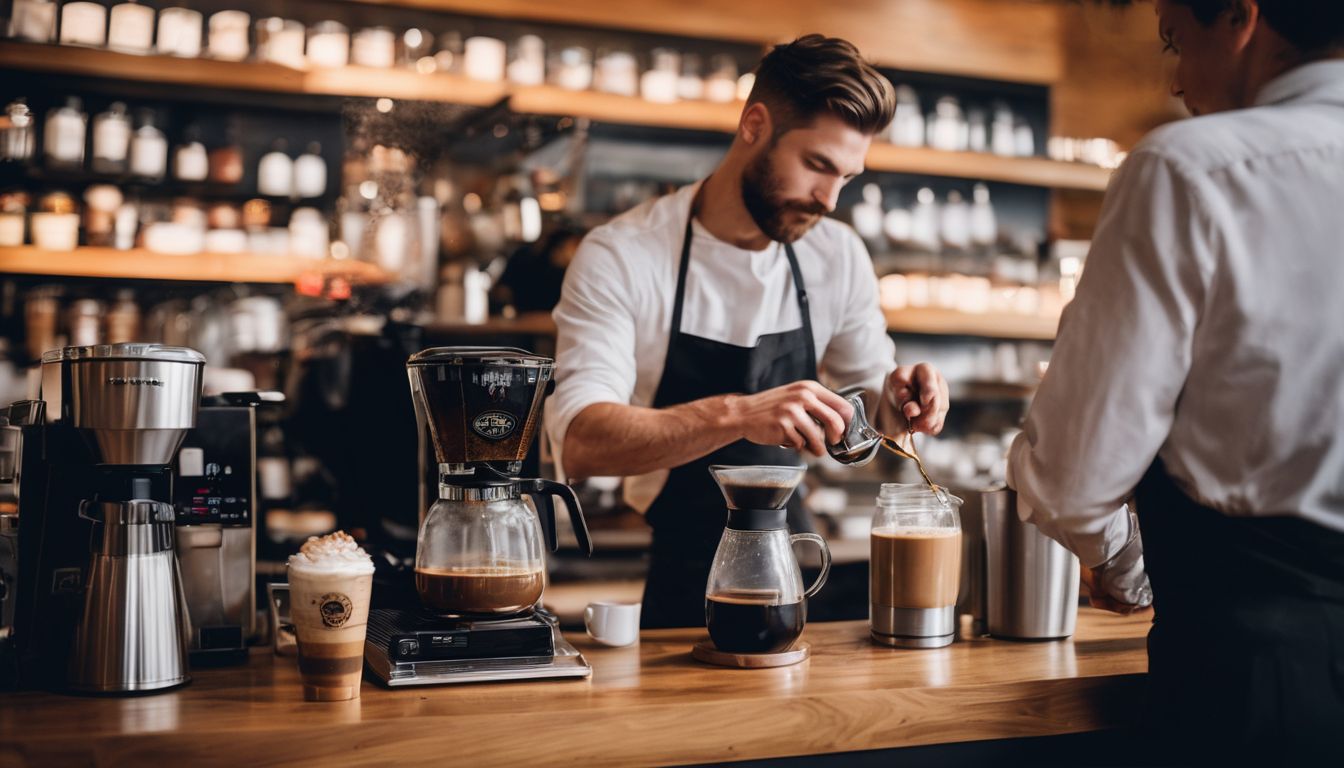
The article explains how each of the six coffee brewing methods works. Here’s a breakdown of how they work:
- French Press Method: You pour hot water over coffee grounds and let it steep for a few minutes. Then, you press down on a plunger to separate the grounds from the coffee.
- Cold Brew Method: You mix coffee grounds with cold water and let them steep in the fridge for several hours or overnight. After that, you strain out the grounds.
- AeroPress Method: You place coffee and water in a chamber, then use air pressure to push the brewed coffee through a filter.
- Siphon Method: This method uses vapor pressure and vacuum suction to brew coffee. Water is heated in one chamber, creating steam which pushes through the ground coffee. As it cools down, it creates a vacuum that pulls the brewed coffee back into another chamber.
- Drip Coffee Method: Hot water drips onto coffee grounds in a paper filter placed in a cone or basket. The brewed coffee drips down into a pot or carafe below.
https://www.youtube.com/watch?v=lVeNTofDB2k
Pros and Cons of Each Method

Let’s explore the flavor profiles, brew times, equipment needed, ease of use, and maintenance for each method. Discover which brewing technique suits your taste and lifestyle.
Flavor profile
The flavor profile of coffee can vary depending on the brewing method you choose. The French press method, for example, offers a smooth and distinct flavor with rich notes. On the other hand, cold brew coffee tends to be smoother and less acidic, making it perfect for those who prefer a milder taste.
Siphon brewers create a clean and flavorful cup of coffee with subtle nuances in taste. Each brewing method has its own unique characteristics that contribute to the overall flavor profile of your homemade coffee.
It’s worth exploring different methods to find the one that suits your taste preferences the best.
Brew time
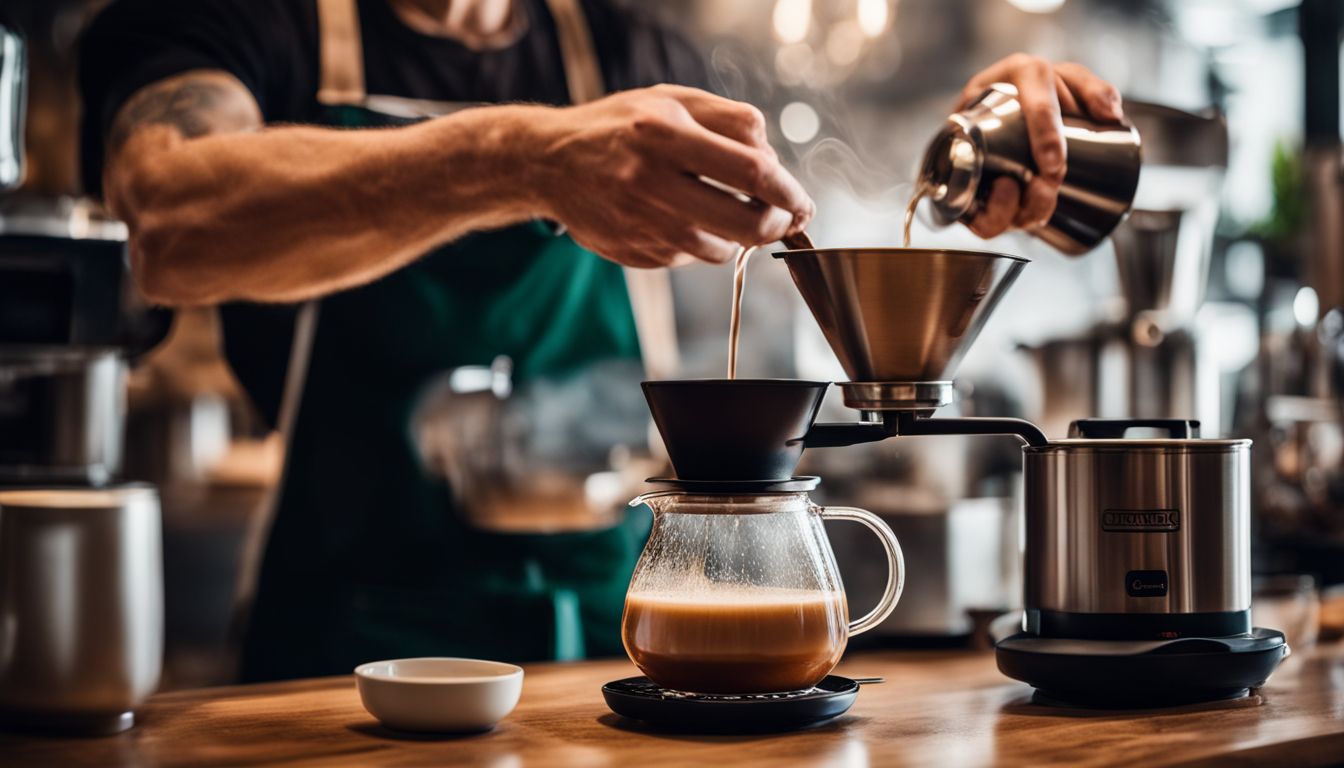
Each brewing method has a different brew time, which affects the flavor and strength of your coffee. For example, if you choose the French press method, it typically takes about 4 minutes to brew a delicious cup of coffee.
The cold brew method, on the other hand, requires several hours of steeping before it’s ready to enjoy. Some methods like instant coffee or espresso are much quicker, with just a few seconds needed to prepare your drink.
So depending on how much time you have and what kind of taste you prefer, you can choose a brewing method that suits your needs.
Equipment needed

To make coffee at home using traditional brewing methods, you will need some specific equipment. For the pour over method, you’ll need a cone-shaped dripper and paper filters. The French press method requires a French press pot with a plunger.
If you want to try the AeroPress method, you’ll need an AeroPress device and paper filters. For the siphon method, you’ll need a siphon brewer set that includes two chambers connected by a tube.
Cold brew coffee can be made using a cold brew pitcher or mason jar with a lid and filter. Finally, for the drip coffee method, all you really need is a simple coffee cone and paper filters.
Ease of use
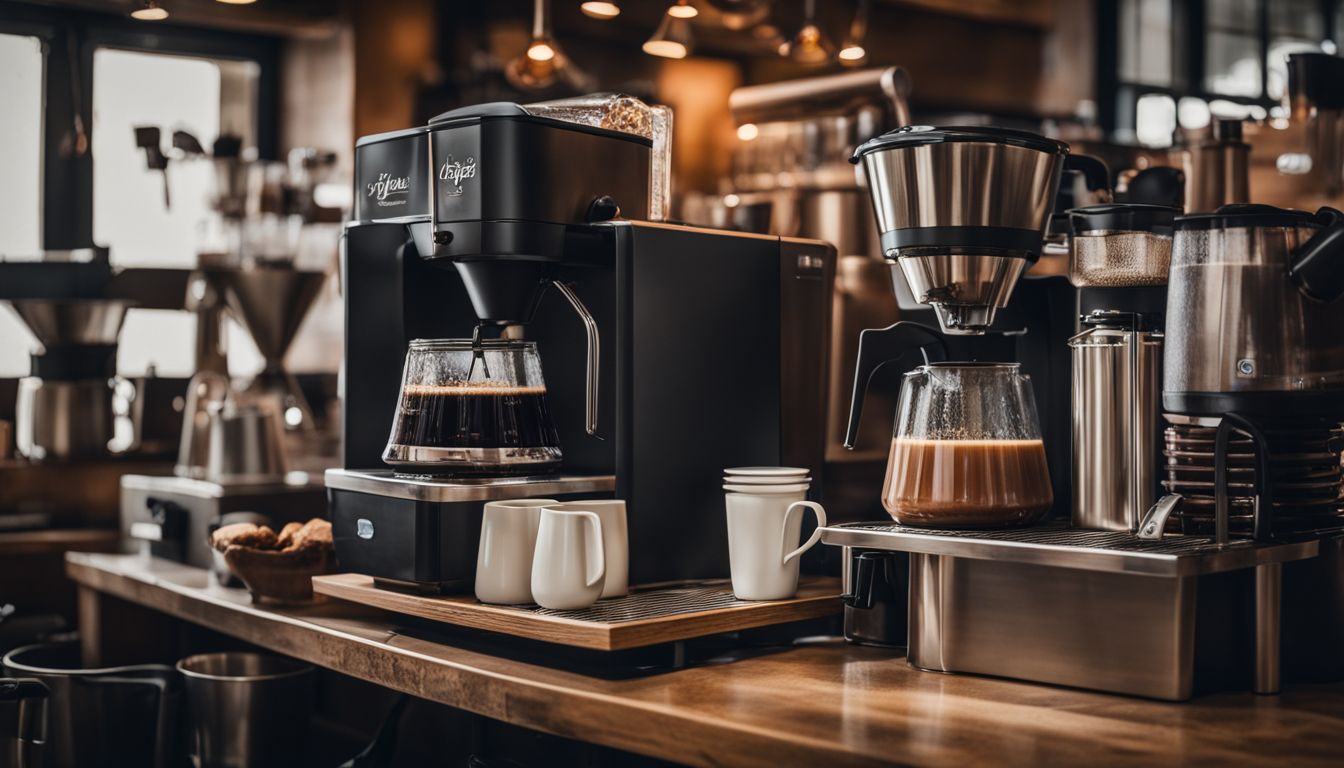
The ease of use is an important factor to consider when choosing a brewing method for making coffee at home. Some methods, like the French press and pour over, are simple and straightforward.
Just add coffee grounds and hot water, then wait for it to brew. On the other hand, methods like the siphon brewer or cold brew may require more setup and preparation time. It’s important to choose a method that fits your lifestyle and preferences, whether you prefer convenience or don’t mind putting in a bit more effort for a delicious cup of homemade coffee.
Remember: there are different ways to make coffee, so find one that works best for you!
Maintenance

Taking care of your coffee brewing equipment is important to ensure that you can continue enjoying a delicious cup of joe at home. Different brewing methods have varying levels of maintenance requirements.
For example, the French press method requires regular cleaning of the plunger and filter to prevent buildup and maintain optimal flavor. The cold brew method involves soaking coffee grounds in water for an extended period, so it’s crucial to clean the container thoroughly after each use to prevent any lingering flavors.
Siphon brewers may require more attention as they involve multiple components that need periodic cleaning and maintenance. It’s essential to refer to the manufacturer’s instructions for specific guidance on how to clean and maintain your brewing equipment properly.
Tips and Tricks for Brewing the Perfect Cup
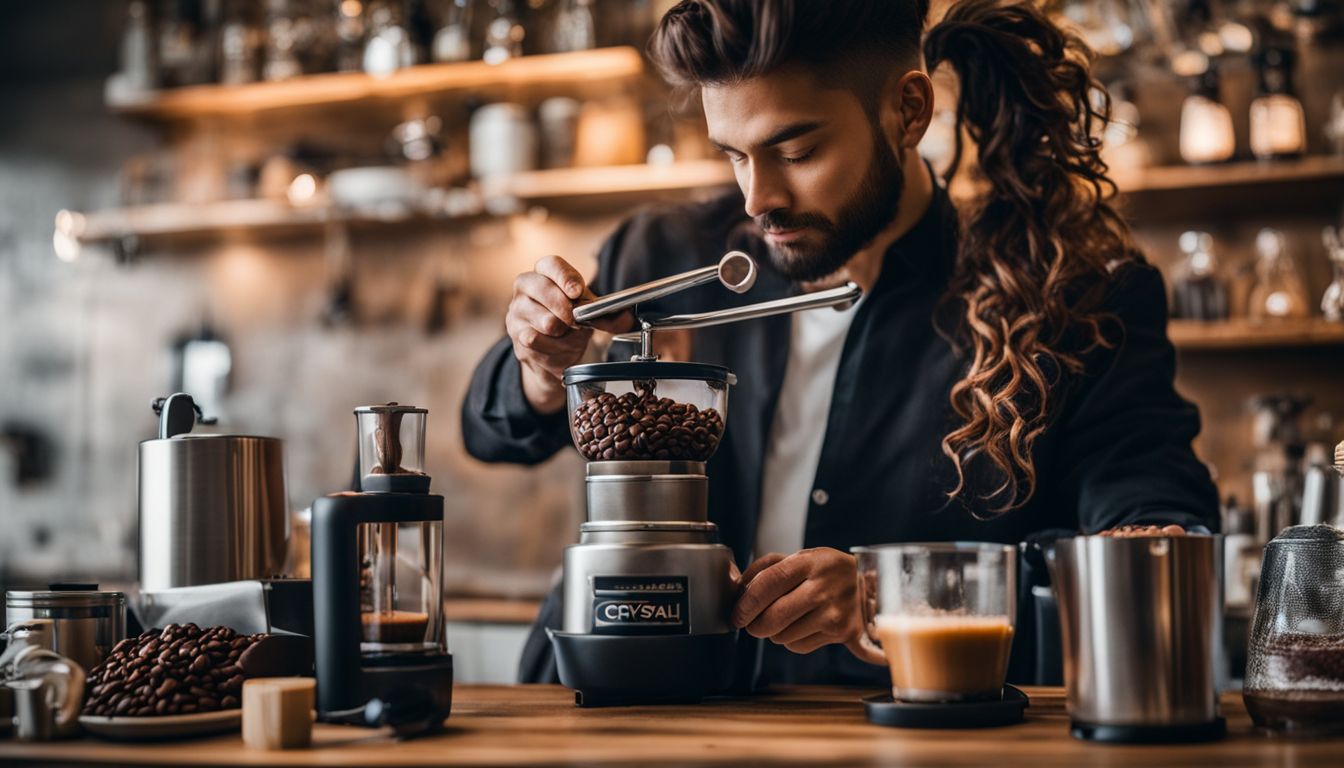
Choose the right grind size, experiment with flavors, and perfect your ratios for a delicious cup of coffee every time. Read more to unlock the secrets to brewing the perfect cup at home.
Choosing the right grind size

The right grind size is important for making a delicious cup of coffee. If the coffee grounds are too coarse, the water will pass through too quickly and result in weak, flavorless coffee.
On the other hand, if the grind is too fine, the water won’t be able to flow through properly and you’ll end up with bitter and over-extracted coffee. To find the perfect grind size for your brewing method, consider these general guidelines: For French press or cold brew methods, use a coarse grind.
For pour-over or drip methods, go with a medium-coarse grind. And for espresso or Aeropress methods, choose a fine grind. Experimenting with different grinds can help you achieve your desired flavor profile!
Water temperature

The temperature of the water you use plays a crucial role in brewing coffee. Different methods require different water temperatures to extract the best flavors from the coffee grounds.
For example, if you’re using a pour-over method, the ideal water temperature is between 195°F and 205°F (90°C-96°C). This ensures proper extraction and enhances the taste of your coffee.
On the other hand, for cold brew coffee, you’ll want to use cold or room temperature water to create a smooth and less acidic cup of joe. Experimenting with water temperature can help you achieve your desired flavor profile when brewing coffee at home.
Brew time
Different brewing methods have varying brew times, which can affect the flavor and strength of your coffee. The drip method using a coffee cone and paper filter is one of the fastest ways to brew coffee at home.
It usually takes around 4-5 minutes for the water to pass through the grounds and into your cup. On the other hand, the cold brew method requires steeping coffee grounds in cold water for an extended period, usually overnight or up to 24 hours, resulting in a smooth and less acidic cup of joe.
Siphon brewers take a bit longer, as they use vacuum and pressure to create a clean and flavorful coffee, typically taking around 8-10 minutes. So depending on how much time you have or how strong you like your coffee, there are different brewing methods to suit your preferences.
Ratios
When it comes to brewing coffee, ratios play an important role in achieving the perfect cup. The ratio refers to the amount of coffee grounds to water used in the brewing process. Getting the right balance is essential for a well-balanced and flavorful brew.
For pour-over methods like drip coffee or French press, a general rule of thumb is using one to two tablespoons of coffee grounds for every six ounces of water. This ratio can be adjusted according to personal preference, with some people preferring a stronger or weaker cup.
The cold brew method requires a higher ratio due to its longer steeping time. A good starting point is using one part coffee grounds to four parts water. This means if you’re using 1 cup of coffee grounds, you would add 4 cups of cold water.
Experimenting with flavors
When it comes to brewing coffee at home, experimenting with flavors is a fun and creative way to enhance your coffee-drinking experience. By adding different ingredients or spices to your brew, you can create unique and delicious flavor combinations.
For example, you can try adding cinnamon or vanilla extract for a hint of sweetness and warmth. If you prefer something more refreshing, you can add a splash of citrus juice or mint leaves.
Don’t be afraid to get creative and try out different flavors until you find your perfect cup of coffee.
Conclusion

In conclusion, exploring traditional brewing methods offers coffee lovers a variety of options to make delicious coffee at home. Whether you prefer the smoothness of French press or the convenience of drip coffee, there is a method that suits your taste.
By experimenting with different techniques and flavors, you can elevate your homemade coffee experience and enjoy the perfect cup every time. So go ahead and try out these traditional brewing methods to discover your new favorite way to brew coffee at home!
FAQs
1. What are the traditional brewing methods for making coffee at home?
The traditional brewing methods for making coffee at home include pour-over, French press, espresso machine, Moka pot, Turkish coffee, and cold brew.
2. Which brewing method is the easiest to use?
The pour-over method is one of the easiest brewing methods to use as it only requires a paper filter, hot water poured over ground coffee in a dripper or cone-shaped device.
3. Is it necessary to have special equipment for all the different brewing methods?
No, you don’t need special equipment for all the different brewing methods. Some methods like French press and Moka pot require specific apparatuses, but others can be done with basic kitchen items like a kettle and measuring spoon.
4. How long does it take to make coffee using these traditional brewing methods?
The time required to make coffee using these traditional brewing methods varies depending on the method chosen. It can range from a few minutes with pour-over or French press to several hours with cold brew.
